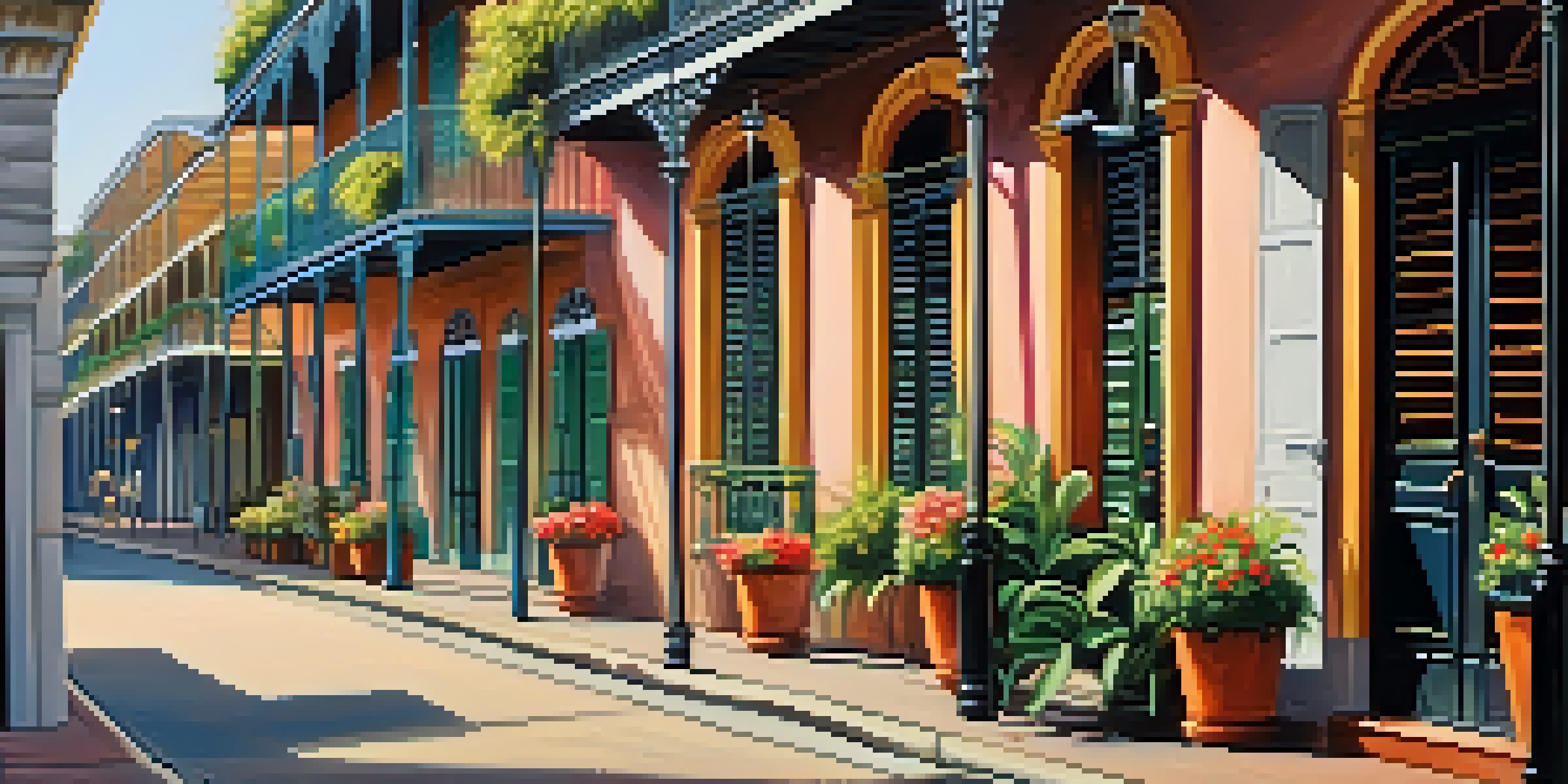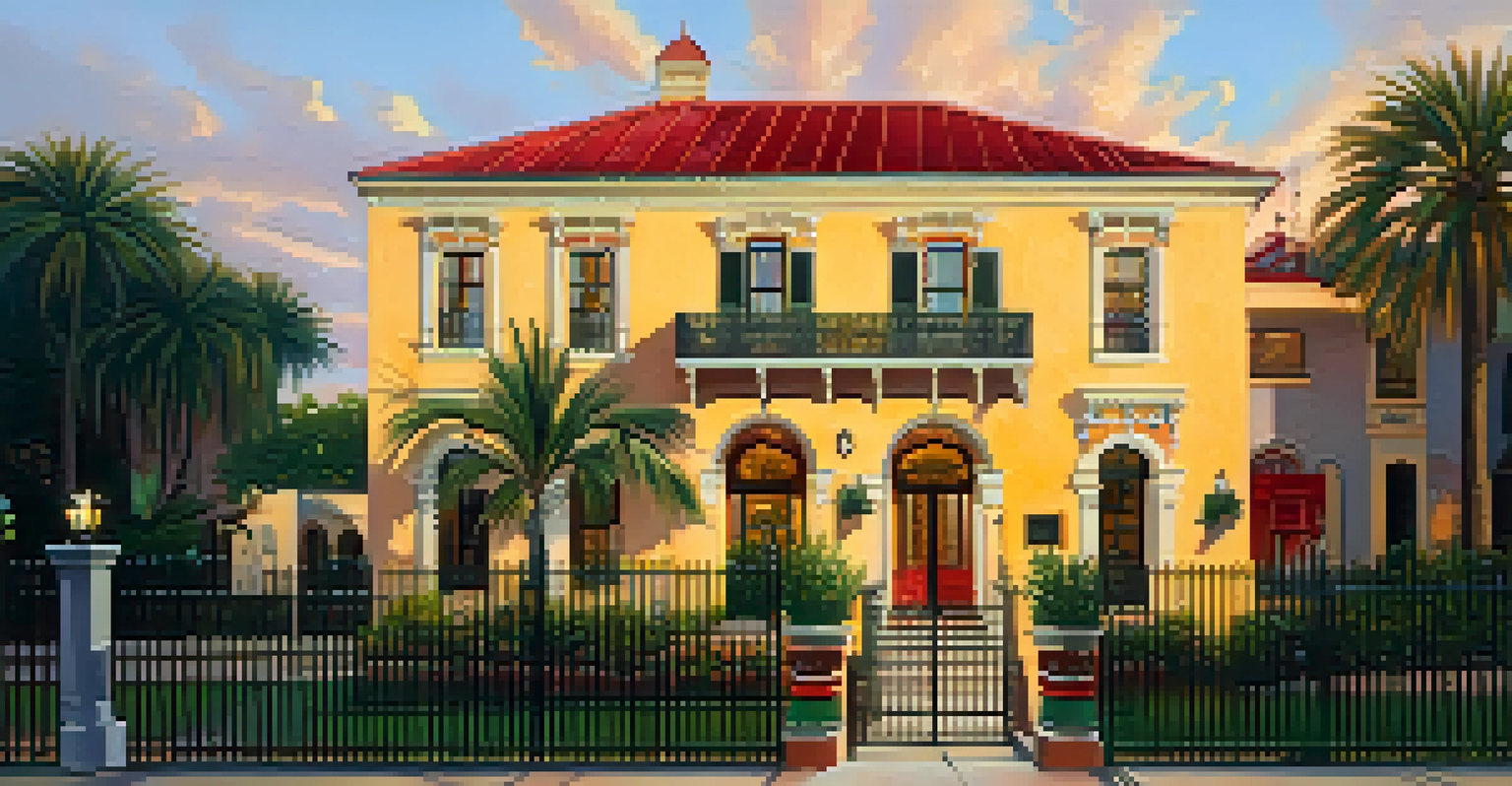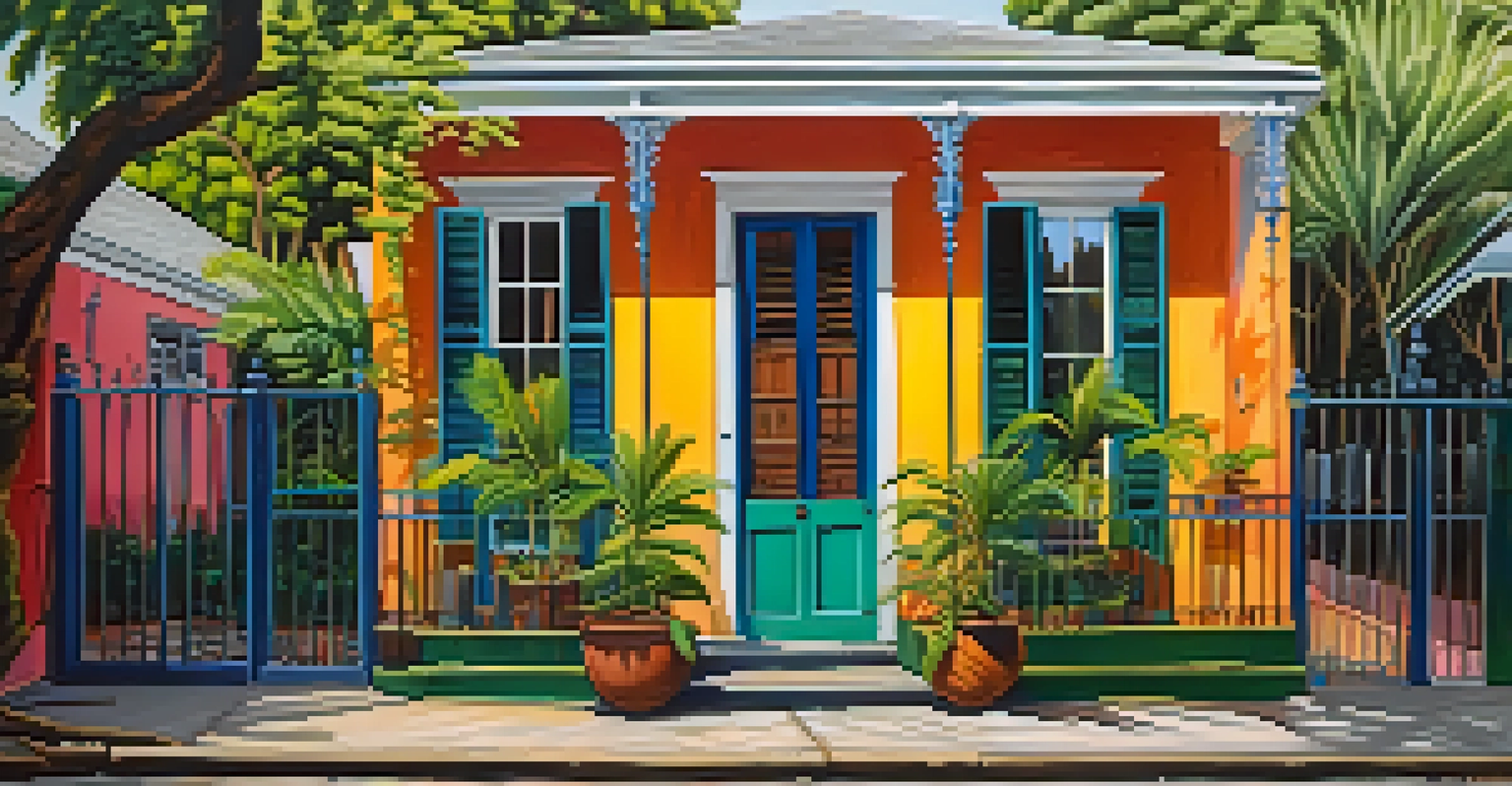Architectural Styles Reflecting New Orleans' Diverse History

The French Colonial Influence on New Orleans Architecture
New Orleans' architectural story begins with the French colonial style, which laid the groundwork for the city's unique aesthetic. Characterized by its use of local materials like cypress and brick, this style often features wide porches and steep roofs, ideal for the humid climate. The famous Vieux Carré, or French Quarter, is a prime example, showcasing charming buildings that transport visitors back to the 18th century.
Architecture is the art of how to waste space.
You'll notice the intricate wrought-iron balconies that adorn many structures, a nod to the craftsmanship of that era. These features not only enhance the visual appeal of the buildings but also reflect the social dynamics of the time, as balconies served as spaces for social interaction. This architectural style is a testament to the French influence that permeates the culture of New Orleans.
As you stroll through the streets, it's impossible to ignore how these colonial influences blend seamlessly with later styles, creating a rich tapestry of history. The French colonial architecture is just the tip of the iceberg, but it sets the stage for the diverse styles that followed, each adding a new layer to the city's identity.
Spanish Colonial Revival: A New Chapter in Architecture
Following the French influence, the Spanish colonial period introduced a different flavor to New Orleans' architectural landscape. This style is distinguished by its use of stucco, red-tiled roofs, and arched doorways, giving buildings a distinctly Mediterranean feel. The Cabildo, located in Jackson Square, is a stunning example of this style, with its elegant façade and historical significance.

The Spanish colonial revival style was particularly influential in the 19th century as architects sought to celebrate the city’s colonial past. You can see this reflected in the vibrant colors and ornate details that characterize many buildings from this period. This architectural style not only adds to the visual diversity of the city but also underscores the cultural shifts that occurred throughout its history.
French Influence Shapes Architecture
The French colonial style laid the foundation for New Orleans' unique architectural identity, visible in its charming buildings and social dynamics.
Walking through New Orleans, you can feel the echoes of both French and Spanish influences, each leaving an indelible mark. The Spanish colonial revival serves as a beautiful reminder of the city’s historical complexities and the blending of cultures that define its character.
The Rise of Creole Townhouses in the 19th Century
As the 19th century progressed, Creole townhouses emerged as a significant architectural style in New Orleans. These narrow, two-story buildings are often adorned with vibrant colors and ironwork details, reflecting the cultural melting pot that is the city's heritage. The style is heavily influenced by both French and Spanish designs, showcasing a unique blend that is distinctly New Orleans.
A building is not just a place to be, but a way to be.
Typically featuring a central hall layout, these townhouses maximize space while allowing for ventilation in the warm climate. The charming courtyards at the back provide a private oasis amidst the bustling streets, inviting residents to enjoy the outdoors. Creole townhouses not only exemplify practical design but also serve as a canvas for the artistic expressions of their inhabitants.
As you explore neighborhoods like Faubourg Marigny, the beauty of these townhouses becomes apparent. Their architectural significance goes beyond aesthetics; they represent the resilience and creativity of the city's residents throughout its tumultuous history.
Gothic Revival: A Touch of Elegance and Mystery
The Gothic Revival style made its mark in New Orleans during the mid to late 19th century, bringing an air of elegance and mystery to the city's architecture. Characterized by pointed arches, intricate details, and dramatic spires, this style can often be seen in churches and public buildings. St. Louis Cathedral, with its stunning Gothic elements, is a prime example of how this style has been embraced in the city.
These structures often evoke a sense of history and reverence, drawing visitors and locals alike to their grandeur. The use of dark, rich colors and elaborate decorations creates a striking contrast against the warm tones of the surrounding architecture. The Gothic Revival not only adds to the visual diversity of New Orleans but also offers a glimpse into the spiritual and cultural values of the time.
Cultural Blending in Architectural Styles
New Orleans' architecture is a rich tapestry of various influences, including French, Spanish, and Victorian styles, reflecting its diverse cultural history.
As you wander through the city, the Gothic Revival buildings stand as a testament to the artistic movements that shaped New Orleans. They remind us of the importance of architecture in conveying both beauty and meaning, enriching the city's narrative.
The Influence of Victorian Architecture in the 19th Century
Victorian architecture found its way to New Orleans in the 19th century, bringing with it an abundance of decorative details and unique design elements. This style is characterized by its asymmetrical shapes, vibrant colors, and intricate trim work, making it a favorite among many homeowners. The Garden District is a treasure trove of Victorian-style homes, showcasing everything from Italianate to Second Empire designs.
Victorian architecture often features large verandas and ornate woodwork, inviting a sense of warmth and charm. These homes not only reflect the wealth and aspirations of their original owners but also tell stories of the city's social history. The eclectic mix of styles within the Victorian era demonstrates the creativity and individuality that New Orleans residents embraced.
Strolling through the Garden District, you can't help but be captivated by the elaborate facades and lush gardens. Victorian architecture adds yet another layer to New Orleans' diverse architectural tapestry, reminding us of the city's vibrant past and its ability to evolve.
Art Deco: A Bold Departure from Tradition
Emerging in the early 20th century, Art Deco introduced a bold and modern aesthetic to New Orleans' architectural landscape. Characterized by geometric shapes, bright colors, and ornate details, this style marked a departure from the more traditional designs that came before it. The Saenger Theatre stands out as a prime example of Art Deco architecture, with its stunning façade and lavish interior.
Art Deco was not just about style; it represented a cultural shift towards modernity, reflecting the optimism of the Roaring Twenties. Buildings adorned with vibrant tiles and streamlined forms contributed to the city's evolving identity during this dynamic period. This architectural movement captured the spirit of the times, showcasing the creativity and innovation of its designers.
Contemporary Designs Embrace Sustainability
Recent developments in contemporary architecture highlight a commitment to sustainability while honoring the historical context of New Orleans.
As you explore the city, the Art Deco buildings serve as a reminder of New Orleans' ability to embrace change while honoring its past. These structures invite us to appreciate the blend of tradition and modernity that defines the city’s architectural character.
Contemporary Architecture: The Future of New Orleans' Design
In recent years, contemporary architecture has begun to carve out its own space within New Orleans' rich architectural narrative. This style often emphasizes sustainability, innovative materials, and open spaces, reflecting a modern approach to design. The new structures are often juxtaposed against the historic buildings, creating a dialogue between past and present.
Contemporary architecture in New Orleans embraces the city's unique culture while addressing current environmental challenges. Features like green roofs and energy-efficient designs are becoming more common, showcasing the city's commitment to sustainability. This evolution in architecture not only meets the needs of the present but also honors the legacy of the past.

As you traverse neighborhoods undergoing revitalization, the blend of contemporary and traditional architecture tells a story of adaptability and resilience. The future of New Orleans' design is bright, with contemporary styles continuing to add vibrancy and innovation to the city's already diverse architectural landscape.
Conclusion: A Living Tapestry of Architectural Diversity
New Orleans stands as a remarkable testament to the power of architecture in telling a city's story. From the French colonial styles that first defined its landscape to the contemporary designs shaping its future, each architectural style encapsulates a piece of the city's history. This living tapestry reflects the diverse cultures and influences that have converged in New Orleans over centuries.
As you explore the streets of this vibrant city, take a moment to appreciate the beauty and intricacy of its architecture. Each building, whether it be a Creole townhouse or a modern sustainable structure, contributes to the rich narrative of New Orleans. The architecture is not just about aesthetics; it's a celebration of the city's spirit and resilience.
In understanding the various architectural styles, we gain insight into the lives and cultures that have shaped New Orleans. This architectural diversity invites us to embrace the past while looking forward to a future filled with possibility, making New Orleans a truly unique destination.